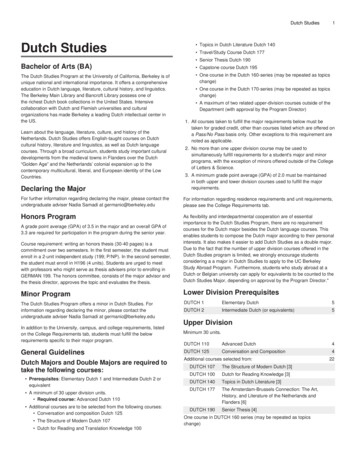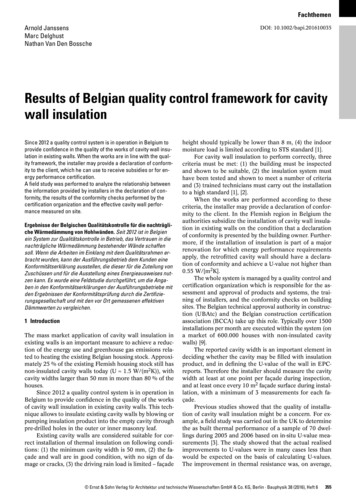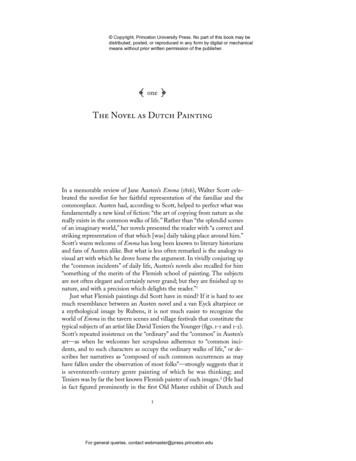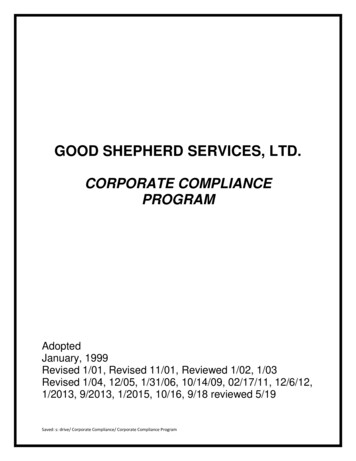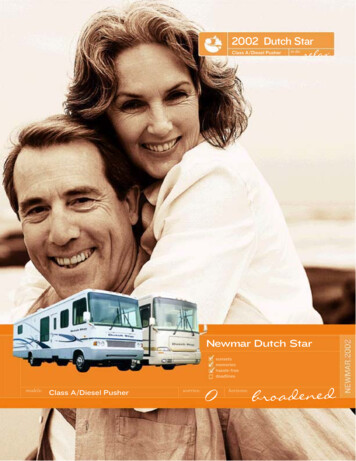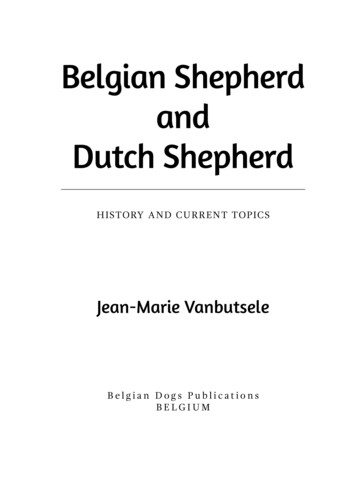
Transcription
Belgian ShepherdandDutch ShepherdHISTORY AND CURRENT TOPICSJean-Marie VanbutseleBelgian Dogs PublicationsBELGIUM
Copyright 2017 by Jean-Marie Vanbutsele.All rights reserved. No part of this publication may be reproduced, distributed or transmitted in any form or by any means, including photocopying, recording, or other electronic or mechanical methods, without the prior written permission of the publisher, except in the case ofbrief quotations embodied in critical reviews and certain other noncommercial uses permitted by copyright law. For permission requests,write to the publisher at the address below.Belgian Dogs PublicationsDonkereham 271880 Kapelle-op-den-Bos, Belgiumwww.belgiandogs.beBook layout and translation: Pascale VanbutseleCover image: Dutch Shepherds Aloha kãkou Lani Lotje andAloha kãkou Riek Wai-Kìkì, photo by Iris Wyss, SwitzerlandBelgian Shepherd and Dutch Shepherd/ Jean-Marie Vanbutsele —1st ed.Legal deposit: D/2017/9.508/2ISBN 978-9-0827532-1-9BISAC: PET008000 PETS / Reference
ContentsThe Belgian Shepherd, History and Current Topics .1The death of Adolphe Reul . 1The origins of the Belgian Shepherd Dog. 7‘White’ in the Groenendaels .55The brindle Belgian Shepherds .58Judgements and statements from the Huyghebaert brothers .62From 1915 to 1920.70The book written by Jos M. Panési, published in 1916 .72The breakthrough of the Malinois in the years 1920 to 1925 .75For the return of the black short-hair .81The ‘blues’ invade our Malinois!.90Standardised nomenclature of coat colours in dogs .92The usefulness of intervariety matings .94Influence of dopamine on Malinois behaviour .100Proposal to update the Breed Standard .103The Dutch Shepherd . 119History of the Dutch Shepherd: from the origin until 1913.120Various articles about the Dutch Shepherd Dog .148Belgian Shepherds and Dutch Shepherds with rough hair .153The Standard of the Dutch Shepherd .170Early 20th century interrelations .178The best friend among our friends . 185Tribute to G’Lady . 187Jean-Marie Vanbutsele, historian of the Belgian Shepherd . 191
†† I would particularly like to thank Fabienne Guéneau.Without her, I would never have known that this lastmanuscript of my father existed and this book would nothave seen the light of day.††
PrefaceFrom the oblivion of history to the rejected StandardproposalThe first part of this work is devoted to the brilliant analysis by LouisHuyghebaert on the origins and the first years of the Belgian Shepherd. The original illustration has been enriched and some summarytables of the origins of the varieties have been added. It is a report ofhigh informative value. It is followed by numerous articles that bringthe forgotten history chapters back to the surface.What to think about how the Société Royale Saint-Hubert (SRSH)is managed? They recently rejected a proposal to update the BreedStandard for the Belgian Shepherd. Without any argumentation, theSRSH responds laconically that the proposal does not have any added value. The best response to counter this unfounded excuse is topublish the entire text of the proposal and its motivation here in thisbook. It is followed by the Breed Standard update proposal with allthe proposed changes, including the application of the relevant FCIguidelines as well as the recommendations on health.A good part of the book is devoted to the history of the DutchShepherd Dog. Why this interest? It was Louis Huyghebaert who ledme along this path and more particularly his article entitled: Roughhaired Belgian and Dutch Shepherds. With common features such asthe same origin, structure and genetics, it can be said that the DutchShepherd is the twin brother of the Belgian Shepherd. Only the brindle coat colour has become their prerogative. All this emerges fromthe many writings evoked in the chapter on the Dutch Shepherd.Jean-Marie Vanbutsele, Brakel, October 2015
Note about the translation:The original articles and citations included in this book were written inold-fashioned and quite verbose French. Although I have tried to retainsome of the style of the period, I often had to ‘modernise’ the translation tomake the sentences comprehensible to the modern reader.Pascale Vanbutsele
BELGIAN SHEPHERD AND DUTCH SHEPHERD 7The origins of the Belgian Shepherd DogBy Louis Huyghebaert‘I shall endeavour to explain how Professor Adolphe Reul succeededin making the shepherd dog transition from the herd to the bourgeoismilieu, and how his efforts were followed abroad.When I had just left Mechelen, I had the good fortune to meet Professor Reul on one of his trips to Neckerspoel, where, before the introduction of cattle, there was a flourishing trade in Dutch dairy cows.Most of these were imported from Holland and kept in the meadowsalong the Dyle, between Neckerspoel and Muizen, until the farmerscame to buy them at the weekly markets of Mechelen.Reul was a member of the jury which would appoint the winners atthe annual cattle competition in Mechelen. It was also Professor Reulwho was usually selected by our government to represent Belgium atinternational meetings abroad. It was on one of these occasions that hewas able to make the following observation about the region, considered as the country of origin of the ancestors of our present Malinois,who, as we know, were initially classified as short-haired Belgian Shepherd Dogs.It is in the Antwerp Kempen2 in the direction of the Dutch border,and later in North Brabant, that this type of short-haired shepherd dogshas kept its consistency.‘Great was my astonishment to meet last year (7 September 1892),on the occasion of an agricultural exhibition organised by theNoord-Brabantse Maatschappij van Landbouw in Oosterhout, a fewhours away from the Antwerp border, a dozen short-haired sheepdogs of the most characteristic type, belonging to farmers in the vicinity.I possess, so continues Reul, a not so good photo of this group ofsimilar looking dogs. They are the size of a fox or a wolf: they areshort-haired and brindle-coloured, their ears are beautifully perpendicular, fine and pointed, and open towards the front. Other features:the muzzle is rectangular and sharp, the nose is jet black, the tail well2 Region east of the city of Mechelen, Campine in French
8 J E A N - M A R I E VA N B U T S E L Eworn, almost horizontal, but slightly raised at the tip, is hairy, in theshape of a spike.’To fix the form of this type of dogs through inbreeding, ProfessorReul addressed a letter to all the former pupils of the Veterinary Schoolof Cureghem and all the Belgian Veterinary surgeons. He invited themto look for the most typical dogs in their respective area and to encourage their owners to send them to the exhibition of the VeterinarySchool in Cureghem, Brussels.And so, on 15 November 1891, 117 shepherd dogs were gathered,‘thanks,’ writes Reul, ‘to the patriotism of the veterinarians, who alwaysknow how to gracefully serve the country when it concerns a questionof public interest.’It is only after studying and carefully comparing all these variousshepherd dogs that the Club du Chien de Berger Belge founded on 29September 1891, established by its General Assembly of 2 April 1892,the characteristic points of the breed obtained by Professor Reul’s comparative studies.The latter gathered information in particular by consulting foreignsources, which he lists in his book: Menault, inspector of agriculturein France and his compatriot, veterinarian Megin. Hugh Dalziel, theauthor of The Collie published in 1888, and Ludwig Beckman for theGerman Shepherds.As stipulated in the Belgian club’s first regulation, published in1898, the aim was ‘the pursuit of improving the native shepherd dogsby inbreeding’. But before starting the creation of families by inbreeding and selection, it was necessary to make a first choice among the bestexisting types. I will try to clarify this with pictures. What I want to emphasise now is the international nature of the first efforts of ProfessorReul and his devoted collaborators.In 1898, at his insistence, I founded a club in Mechelen, togetherwith a group of amateurs, to concentrate exclusively on the improvement of the short-haired sheepdog, which, as mentioned before, originated from the Mechelen area. Dr Gustaaf Geudens, a veterinarian anddirector of the communal slaughterhouse, was its chairman. The clubwas a section of the Brussels club.The first illustrated brochure about the shepherd dogs was published by this club in Mechelen in 1898, and Reul, who had kept incontact with foreign amateurs, asked me to send a copy to Arthur
BELGIAN SHEPHERD AND DUTCH SHEPHERD 9Meyer, the first secretary andco-founder of the Verein fürDeutsche Schäferhunde (German Shepherd Dog Association). It was, writes Reul, tomake the Belgian shepherdsknown through photographs.Arthur Meyer, who wroteand spoke French fluently,sent me in exchange the characteristic breeding points ofthe German Shepherd, fixedat Frankfurt am Main on 30September 1899, as well as hisnotes as a judge of these dogsat the first special exhibition,organised in the same city. Hetold me at the same time thathe would quickly send me aLetter from Reul to Huyghebaertcopy of the first edition of therichly illustrated Breed Standard of the German Shepherd, as soon asit was ready.Arthur Meyer was not able to complete this project, and it wasnot until a year after his death that his successor, the Rittmeister vonStephanitz, sent me the promised brochure. It contained no less thanfifty photos and drawings, starting of course with the Stammvater(founding father) Wolf, who was close to his heart. It ended with aportrait of what all the German breeders had produced up to that time.Strangely enough, Professor Reul’s studies are not mentioned in thisimportant and carefully laid out book. There is only an image of thetypical representatives of other European shepherd breeds.Tjop — about whom I shall speak later — is depicted as the best representative for the short-haired Belgian Shepherds and the couple Miraand Bazoef as typical Belgian rough-haired shepherds.The initiative taken in Belgium in 1891 by Professor Reul was notonly echoed in Germany but also in France and Holland. It was onlyin Germany that immediate practical direction was given to breedingshepherd dogs by creating, on a commercial basis, the Verein, whichlater became so powerful.
B E L G I A N S H E P H E R D A N D D U T C H S H E P H E R D 33The descendants of Tjop and Dewet‘If I went into detail about theorigins of Tjop and Dewet, it ismainly because these two dogsgave their names to two familylines. Their matings and lineagelater gave us admirable offspring.Among them is Fram du Bois de laDeule, French champion, ownedby Mr Danna from Lille, and thevaliant representative of the Malinois variety in the north of France.Fram du Bois de la DeuleThe grandmother of Fram duBois de la Deule (LOSH 8297) was Flèche II (LOF 11898), offspringfrom Tjop and Lolo de Watermael and owned by Mr Duchenoy, the firstsecretary of the Club du Chien de Berger Belge.If we descend further down the pedigree, we meet an even morefamous descendant of Tjop and Dewet: Ninon de l’Enclus, belongingto Mr Couvreur, the well-knownbreeder from Amougies (nearRenaix). Ninon was so perfectin all respects that for sevenyears (1907-1914), she held thefirst place in all the dog showsorganised during this period.Meanwhile, other breeders hadalso used Tjop’s blood. The ‘Chenil des Elfes’ of Mr Marcel Cotte,had a typical representative inRolf des Elfes, a grandson of Tjop,both on the paternal and maternalside.Ninon de l’EnclusThe kennel ‘Ter Heide’, sold byyour servant to the knight Hynderick of Theulegoet, used as stud dog,after selection, Knap ter Heide, a son, grandson and great-grandson ofTjop.These two kennels and many others — it would be too long to listthem all — disappeared in the unhappy years 1914-1918 and among the
34 J E A N - M A R I E VA N B U T S E L Epost-war dogs, none of their direct descendants came to shineas a ‘great’ dog.Based on the same principles, many dogs were bred inthe Mechelen area, especiallyafter the police dog competitions — about which I will elaborate later on — had made thegood reputation of the Malinoisknown everywhere.By chance a Malinois fellintogood hands; it was Wip,Knap ter Heideraised by Mr Beullens fromSint-Katelijne-Waver, near Mechelen. Wip had Tjop as father and hismother, was a daughter of the same male. Although not free from defects, Wip was nevertheless a remarkable animal with a noble head anda typical expression.From left to right : Bergeot du Bois de la Deule, Luronne de la Saulx and champion Framdu Bois de la Deule, Malinois owned by Mr Georges Danna.
B E L G I A N S H E P H E R D A N D D U T C H S H E P H E R D 35After being sold to a Frenchman near Valenciennes, he was noticedthere by a connoisseur from Mons and brought back to Belgium. In thefemale offspring from Dewet, who then lived in the same area in Wallonia (Frameries), suitable mating material was found for reproduction.His best offspring were dogs from the daughters of Tjop, especiallyBeth, who with Wip gave Tititte and Dingo (LOSH 3199).MastockDingo belonged to Mr Dupuis from Bracquegnies who was a veryprominent breeder in Wallonia. Although Dingo served very little asa stud dog, he nevertheless produced some stars such as Fram du Boisde la Deule, mentioned above, and Mastock. The latter comes fromCorette, daughter of Dewet and Wanna II, sister of Beth, already mentioned, and the daughter of Tjop.One of the best bitches in Mr Danna’s kennel was Flèche II, daughterof Tjop and Lolo de Watermael. Her mating with Duc de Bruges gaveJavotte du Bois de la Deule, who, with her father’s pretty fawn colourand soft black mask, unfortunately also brought flabby ears that did notpoint easily. This was due to her overly frail constitution.
58 J E A N - M A R I E VA N B U T S E L EThe brindle Belgian ShepherdsAt the time, there was a very well built short-haired male with a brindlefawn coat, who was never beaten in the exhibitions where he won seven first prizes. This dog was Samlô owned by Prosper Beernaert. Due tothe lack of assorted bitches, this stud dog did not have the opportunityto reproduce his typical features in suitable conditions.Samlô, Belgian Shepherd Dog with short hair owned by Mr P. Beernaert from Brussels,drawing by Alexandre Clarys (1897).There were many brindledogs at the time and dogs couldbe born without a tail, as attested by this classified ad publishedin Chasse et Pêche:
B E L G I A N S H E P H E R D A N D D U T C H S H E P H E R D 59The Club du Chien de Berger Belge committed itself in 1898 toachieve uniformity by selecting a particular colour for each of the threetypes of coat according to the following terms: solid black for the long-hair, fawn with black overlay (with a black mask as much as possible)for the short-hair, dark ash grey for the rough-hair.Was it right or wrong to enact such a measure? The choice of theunique colour for rough-hair was the most unfortunate of all. Dark ashgrey dogs were exceptions. Despite the exclusion from the Club, themajority of this variety were fawn coloured dogs. Opponents of thisrestrictive classification met and founded the Berger Belge Club on18 July 1898. Joseph Demulder was chairman of the association untilJanuary 1931. On 24 September 1899 the Standard assigning a distinctcolour by hair type was published in Chasse et Pêche. Charles Hugecommented:‘This decision repudiated all the choice breeders of the other colours, i.e. sixty per cent of the shepherd dogs that were living in thecountry at that time, among which the brindle dogs were the mostnumerous.’During the dog show organised on the occasion of the 10thanniversary of the foundation of the Club du Chien de Berger Belge inBrussels on 21 April 1901, the judge counts no less than nine dogs thathe describes as brindled in his report on short-hairs. Some of them hadrough hair.
60 J E A N - M A R I E VA N B U T S E L EDog show in Jemeppe-sur-Meuse at the Cockerill factories on20 and 21 June 1914At the major ‘all breeds’ dog show organised by the Club du Chien deBerger in Jemeppe at the Cockerill factories, the black short-hairedshepherds are well represented. The sixteen enrolled dogs formed aperfectly homogeneous group. Show judge Legros wrote in his report:‘This variety is undoubtedly definitively created, thanks to the numerous enthusiasts in the Liège region who direct their breedingtowards this new type. Remember that black short-haired shepherddogs are gifted with superior intelligence. They are easy to handleand have a social character. At the same time, they have a good bitewhen attacking and are very devoted to their master. They also havea strong sense of smell.’Dickson belonging to Joseph Lambert and Mirette belonging toÉmile Gateaux won the first prize in the open class. At the same exhibition in Jemeppe brindled dogs with long hair made their reappearance.But what happened to our brindleswho were once prize-winning atdog shows? Since their eviction in1899, many of the excluded dogs,born in Belgium to Belgian parents, were registered in the StudBook as ‘Dutch Shepherd Dogs’.Some pedigrees even bear themention: ‘Belgian Shepherd Dogcalled Dutch’. One of the most famous of them (because you willfind him in many pedigrees) isRaksha der Bastaarden, brindle born from none other than Sam registered inthe Dutch NHSB Stud Book withGroenendael parentsnumber 1488.About brindles and in response to a reader’s letter (Chasse et Pêcheof 20 September 1913), Charles Huge develops some genetic aspectsunder the heading ‘All our shepherds are a single family’:‘You say that your purebred Groenendael bitch has been mated witha purebred Groenendael male and yet you get two brindles; you are
B E L G I A N S H E P H E R D A N D D U T C H S H E P H E R D 61confident that this mating was unique. Nothing more natural. Beforethe selection of blacks, yellows, etc., the shepherds of our farms, whodidn’t care much about the coat colour (not a single one was in fashion), crossbred their dogs to obtain working qualities. However, asthere were a majority of brindle dogs in Belgium, it is quite normalthat according to the laws of heredity, even after six or seven generations, the colour would return. For thirty years people have beentrying to eliminate white spots from the Irish Red Setter to complywith ‘fashion’ (which I don’t question, but which did a lot of harmto all the breeds where this principle was applied exclusively for dogshow purposes). However, there are few red litters where the whitespot doesn’t appear at birth. The same goes for the Gordon Setters.I recall a most extraordinary case of a Tervueren shepherd who wonthe first prize in an exhibition and came from two very purebredand dog show winning Malinois. Nature sometimes has more tenacity than breeders and manages to thwart their fantasies for occultreasons that should not be scorned.Your brindle dogs will undoubtedly be models of the new ‘wonderful’ variety, on the day when a club will give them a name that willsuit them and will earnestly take care of this variety. Everythingcomes to an end in this world, but one day everything comes backwith a novelty label. Until the clubs have accepted this colour asone of the most Belgian, you will be condemned to register them asDutch Shepherds. And if they’re well built, you’ll win prizes. It maybe a little illogical. ‘Sed lex.’ (That is the way of the world.)’
118 J E A N - M A R I E VA N B U T S E L EDutch Shepherd with fawn brindle short hair, photo by Pauline van Vliet
120 J E A N - M A R I E VA N B U T S E L EHistory of the Dutch Shepherd: from the origin until1913The years before 1898It was during the last quarter of the 19th century that official cynologyin the Netherlands began to show interest in the ‘native shepherd dog’.Something similar also happened in Germany, Belgium and other countries. The wide-open spaces of moors and heathland stretched acrossnational borders. The flocks with their shepherds and dogs grazed inits vast expanses.It was not about the outwardappearance, but about abilityand character. In those days, thedogs, now our national breeds,resembled each other more thanthey do today. Rough, short orlong coats were mated betweenthem. Colour was not taken intoaccount. The use as a workingdog was the only criterion. OnlyDutch shepherd with his dogthe Scottish Collie had alreadybecome a show dog.In 1874 the Koninklijke Nederlandse Jagersvereniging Nimrod(Royal Dutch Hunters Association Nimrod) was founded. They createdthe original NHSB (Nederlandse Honden Stamboom) Stud Book andorganised dog shows. Later, in 1901, the Raad van Beheer op Kynologisch Gebied (Cynology Management Board) was formed and tookover the original NHSB Stud Book, the recognition of dog associations,the regulation of dog shows, etc.On 11 and 12 April 1874, the first indigenous shepherd dog wasshown in Amsterdam during a livestock exhibition. In 1875, the description of such a dog was published by the Nimrod in a book forjudges.In the catalogue of the second dog show held in 1878, the mention‘Native Shepherd Dogs’ was replaced for the first time by ‘Dutch Shepherd Dogs’ (Hollandse Herdershond). For some people, this denomina-
B E L G I A N S H E P H E R D A N D D U T C H S H E P H E R D 121tion was a mistake, and they would have preferred the name ‘ShepherdDogs from the Netherlands’ (Nederlandse Herdershond). We will notenter into this controversy, which has no cynological significance.During the years between 1890 and 1898 the number of dog showsincreased, but barely a dozen Dutch Shepherds were exhibited there.This limited number did not allow to discern the characteristics of thebreed. They were dogs without typical features, no known descent andprobably chosen at random. This did not allow to distinguish the varieties and specific colours.
178 J E A N - M A R I E VA N B U T S E L EEarly 20th century interrelationsbetween the Laekenois, Dutch Shepherd and Bouvier,by Mara Lee Jiles, June 2002.Jan-Baptist Jansen purchased a yellow rough-haired male, Vos, in thearea of Boom, Belgium. Vos, born in 1885, became the foundation sirefor the Laekenois and Malinois varieties of the Belgian Shepherd Dogs,and can also be found in the extended pedigrees of several Dutch Shepherds and early Bouviers, in the Raad van Beheer’s NHSB studbooks.Vos (later designated Vos I) was mated to a brown brindleshorthaired female known as Lieske, or Lise de Laeken. From thismating came Diane and Mouche, (short-hairs who played importantroles in the development of the Malinois), Tom de Vilvorde, a greyrough hair, and Spits, also presumed a rough-hair. Spits was bred backto Vos to produce Moor, a black rough-hair who is also apparently oneof the first recessive blacks in the history of the Belgian Shepherd Dogs.Moor, bred back to her grandsire, Vos, produced Poets, a light fawnrough-haired Laekenois female who did well in several exhibitions atthe end of the 19th Century.Poets played a larger role in this history than previously realized.Bred to her great-uncle, Tom de Vilvorde, she produced Vos II and Bellede Saint-Nicolas. This couple, mentioned only once in the Saint-Hubertstudbooks as parents of Turc,appear numerous times as theancestors not only of Malinois, butearly Laekens, Dutch Shepherds,and Bouviers. Bred to Duc II,Pouts produced Pitt and BelleII, who appear in the ancestryof some Dutch Shepherds, butremain unmentioned in BelgianShepherd history.1901 was the first year thatthe Belgian Shepherd Dogs wereadmitted to the Société RoyaleSaint-Hubert studbooks, but an Zorka (LOSH 7824, NHSB 3044) Famous1898 color decision by the breed rough-haired female shepherd dog ownedby Mr Carl Farenthold.
Shepherd Dog. Why this interest? It was Louis Huyghebaert who led me along this path and more particularly his article entitled: Rough-haired Belgian and Dutch Shepherds. With common features such as the same origin, structure and genetics, it can be said that the Dutch Shepherd is the twin brother of the Belgian Shepherd. Only the brin-
